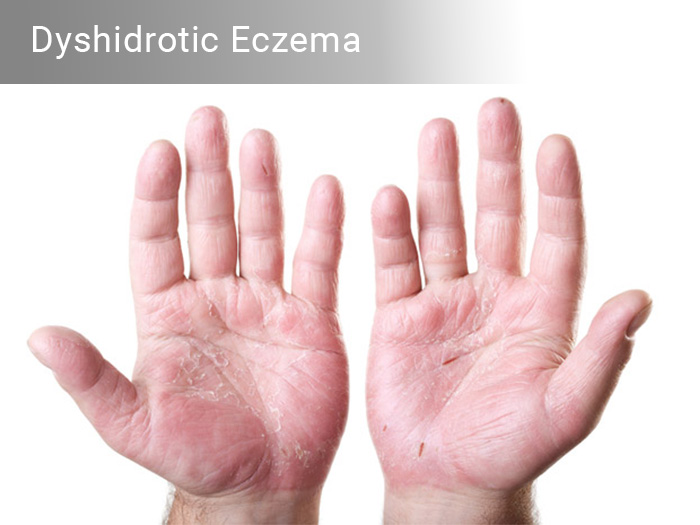 What is Dyshidrotic Eczema?
What is Dyshidrotic Eczema?
The eczema type is characterized by small blisters on hands and feet. Dyshidrotic eczema, or dyshidrosis is most commonly reported near the sides of fingers and palms but it may even affect the fingertips, toes and soles of feet. The pin-head sized blisters occur in clusters. A dermatologist might term this eczema as foot and hand eczema, pompholyx, or vesicular palmoplantar eczema.
The symptoms of eczema are more prominent in women in comparison to men. It usually affects children above the age of 8 but cases of this types of eczema in babies have also been reported.
 Causes
Causes
Dyshidrotic eczema may be caused by:
- high stress levels
- seasonal allergies
- staying in water for too long
- excessive sweating of the hands or feet
The exact cause of the skin disorder is unknown, however, it is supposedly caused by exposure to metallic elements like nickel or cobalt, excessive stress, fungal infection and allergies. If, an individual is allergic to house dust mites, there might be a significant increase in the outbreaks of dyshidrotic eczema.
Also Read: Weeping Eczema Home Remedies
 Symptoms
Symptoms
Symptoms of dyshidrotic eczema include:
- Small blisters on the palms or side of the fingers
- Small blisters on the soles of the feet
- An itching or burning feeling around the blisters
- Sweating around the blisters
The fluid-filled blisters may last from a few days to three or four weeks, depending upon the skin condition. The level of severity can vary from a mild case with a few blisters to a severe case with tiny blisters densely covering the affected areas and severe itching.
With a passage of time, these tiny blisters may get thicker and scaly, resulting in itchiness, redness and inflammation. Without an appropriate treatment, the severe cases may worsen and can result in cracks, open sores and bleeding.
(Now you can track, manage and analyse the symptoms of eczema by downloading this simple Eczema Tracker App)
 How To Prevent Dyshidrotic Eczema?
How To Prevent Dyshidrotic Eczema?

The developed blisters are very itchy and painful. The most important thing to help heal the skin and manage the condition is to avoid scratching the affected area. Frequent scratching may aggravate the symptoms of eczema. If, the urge of scratching is prominent, anti-itch medications can be beneficial to reduce itchiness.
Ensure to use recommended medications. One may be prescribed with the mild antihistamines, such as Claritin or Benadryl, to help reduce the symptoms.
A mild outbreak of dyshidrotic eczema can be controlled by natural measures, which may include simple and effective dyshidrotic Eczema natural remedies. For the severe cases, medical intervention is necessary.

The cause of this skin disorder is not clear. However, factors that can aggravate the condition have been investigated, including exposure to nickel or cobalt, fungal infection, allergies and/or excessive stress.
It’s an itch-scratch cycle, which is typical of eczema. The skin affected by eczema gets thicker and scaly with time, leading to itching, swelling and redness. You can treat Dyshidrotic eczema with home remedies, and follow up with medical intervention for severe cases.
 Most Common Home Remedies For Dyshidrotic Eczema
Most Common Home Remedies For Dyshidrotic Eczema

- Cold and Wet compresses can be helpful in alleviating the discomfort associated with itchy skin.
- Oils, including olive oil, coconut oil and tea tree oil, act as natural moisturizers and anti-inflammatory agents.
- Aloe Vera provides soothing effect to the affected area and helps in building a strong immune system.
- Oatmeal application to subside the eczema symptoms. Oatmeal bath for eczema adults is very helpful in this case.
- Making use of thick ointments or creams to keep the skin hydrated.
- Apple Cider Vinegar to renew skin cells and maintain a healthy skin.
- Omega-3 fatty acid/Fish oil- Fish oil carries hidden benefits that significantly aid in alleviating the symptoms of eczema. It is believed that fish oil rich in omega-3 helps reduce leukotriene B4 that causes inflammation in case of eczema.
- Flaxseed oil – Flaxseed oil can be taken orally or applied topically to get the required benefits. It is supposed to help regulate inflammation.
 Medical Dyshidrotic Eczema Treatments include:
Medical Dyshidrotic Eczema Treatments include:
Your doctor may also recommend using the following twice a day to relieve itching
- Petroleum jelly, such as Vaseline
- Creams such as Lubriderm or Eucerin
- Mineral oil
- Steroid or corticosteroid ointments
In case of a few severe cases, the dermatologist may prescribe immunosuppressant creams like tacrolimus (Protopic) and pimecrolimus (Elidel). The creams are not recommended in case of children and pregnant women.
 Precautionary Measures to treat Dyshidrotic Eczema
Precautionary Measures to treat Dyshidrotic Eczema
- To avoid making your pain and itching more unfavorable, try not to scratch or break your blisters.
- It’s recommended and significant to avoid frequent exposure to water, such as too much hand washing. If necessary, make sure to moisturize them after washing.
- It is advised to avoid hot water baths and showers to prevent dryness of skin. High temperature water can make the body lose its natural oil, thus, making it dry.
- Avoid using products that can aggravate your skin, such as perfumed lotions and dishwashing soap. Prefer using gentle soaps and natural cleansers. Hypoallergenic cleansers are a good option for people with sensitive skin. Also, avoid vigorous scrubbing.
- Extremely sweaty hands or feet may be related to dyshidrotic eczema. Try to keep them dry and make sure to medically treat them as soon as the onset of the skin condition is administered.
- An effective eczema-care routine, including proper moisturization and using prescribed drugs, can help control an outbreak. Follow a diet which is free of nickel. Chocolates, shellfish, almonds are found to be rich in nickel.
- In case if required, cover your hands or feet using breathable fabrics like cotton.
6 Sources
- https://www.medicalnewstoday.com/articles/320831.php
- https://nationaleczema.org/eczema/types-of-eczema/dyshidrotic-eczema/
- https://emedicine.medscape.com/article/1122527-overview
- http://www.dyshidrosis.co.uk/
- https://www.mayoclinic.org/diseases-conditions/dyshidrosis/symptoms-causes/syc-20352342
- https://www.healthline.com/health/dyshidrotic-eczema#treatment





